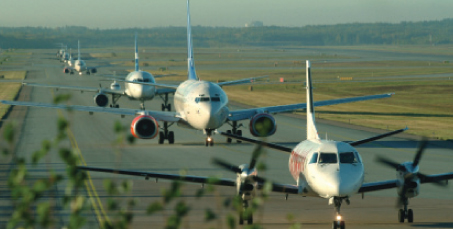
EUROCONTROL’s new Long-Term Forecast (LTF) of flight movements in Europe to 2030 indicates that, under the most likely scenario, there will be 16.9 million movements in 2030 – 1.8 times more than in 2009.
EUROCONTROL’s new Long-Term Forecast (LTF) of flight movements in Europe to 2030 indicates that, under the most likely scenario, there will be 16.9 million IFR (Instrument Flight Rules) movements in 2030 – 1.8 times more than in 2009. “The findings from the 2008 Challenges of Growth study remain generally correct. It is a fact that traffic growth was lower than expected, so around 16.9 million IFR flights are now expected to take place in 2030 as opposed to the 17.5 million predicted in the Challenges of Growth study. This lower growth will obviously put back some of the dates mentioned in the report,” explained Wilson.
The new LTF reuses the LTF08 airport capacity data, extended and refreshed for major recent developments and changes in the plans over the last two years – for example, dropped plans for a third runway at London Heathrow and updated capacity for Berlin-Brandenburg. “In total, the capacity of the system is expected to increase by around 40% between now and 2030, not evenly distributed across the 155 airports covered,” said Wilson.
According to EUROCONTROL forecasts, growth will be faster in the early years and stronger in Eastern Europe, with Turkey being the largest generator of?extra flights in Europe and Germany seeing the greatest number of additional flights in its airspace.
The 2008 Challenges of Growth study highlighted airport capacity challenges and the need for new infrastructure. It forecast that the number of unaccommodated flights would grow rapidly from 0.9 million in 2025 to 2.3 million flights by 2030, meaning that 11% of flights would not be accommodated. The 2010 Long-Term Forecast indicates that around two million flights will be unaccommodated – around 10% of demand. “This is less than in LTF08 mainly because of overall lower forecast levels for 2030 compared to two years ago. The recent drop in traffic has given the system some extra years to react. However, as in the previous forecast, once the limits are reached the congestion spreads and the number of unaccommodated flights grows quickly. With demand growing at similar rates also after 2030, it can be expected that the levels of congestion reported in LTF08 will be reached before 2035,” Wilson commented.
Optimising airport operations
Under the Network Manager function, EUROCONTROL works with airport stakeholders to optimise airport operations. Wilson explained that they must be integrated into the network which allows optimum use to be made of existing capacity and delivers the flexibility that airport operations require.
He said: “Airports generally grow their capacity in line with firm traffic forecasts. Those airports that are nearing capacity do a great job in capacity enhancement and in ensuring they make absolute best use of their runways and other infrastructure. Once an airport is full, then one option is to use secondary airports. The only other option is to build new runways and we know this can be a very lengthy task in getting the permission to start building.”

Wilson: “The findings from the 2008 Challenges of Growth study remain generally correct. It is a fact that traffic growth was lower than expected, so around 16.9 million IFR flights are now expected to take place in 2030 as opposed to the 17.5 million predicted in the Challenges of Growth study.”
In October 2008, ACI EUROPE and EUROCONTROL launched a partnership revolving around the implementation of Airport Collaborative Decision Making (A-CDM); CANSO joined the partnership in October 2010. A-CDM can ensure best use is made of capacity at airport level, and it also allows optimum use to be made of en-route capacity, due the exchange of highly accurate data and the increased predictability this brings. Implementation is underway at around 30 airports, with the target being for 10 European airports to have fully implemented A-CDM by the end of 2011. “A-CDM is at the very core of the airport operation envisaged in the SESAR concept of operations. In fact A-CDM will evolve into SWIM – System Wide Information Sharing,” explained Wilson.
While the decline in traffic in 2008 and 2009 has eased the pressure on airport capacity to a certain extent, in the longer term, demand will grow, resulting in two million flights, or 10% of demand, being unaccommodated in 2030, according to EUROCONTROL forecasts. In addition to unaccommodated demand, airport capacity constraints also affect the flow of operations in the network, which Wilson concluded will make the network more vulnerable to delays.







